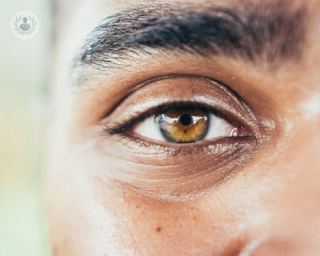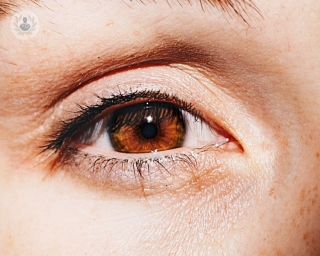Meibomian gland dysfunction (MGD)
Mr Myer Mark Yodaiken - Ophthalmology
Created on: 01-08-2019
Updated on: 03-16-2023
Edited by: Carlota Pano
What is meibomian gland dysfunction?
Meibomian gland dysfunction (MGD), also known as meibomianitis, is a common eye problem where your meibomian glands fail to secrete enough oil onto the surface of the eye. This oil mixes with water and mucus to keep the surface of your eye from becoming dry.
When the glands secreting the oil are blocked, the water on the surface evaporates more easily, causing a number of problems.
What are the symptoms of meibomian gland dysfunction?
The main symptoms of meibomian gland dysfunction are:
- burning and irritated eyes
- dry eyes
- an inflamed or irritated eyelid (blepharitis)
- the sensation of a foreign body in your eye (e.g. sand)
Less commonly, you might experience blurred vision.
What causes meibomian gland dysfunction?
There are a number of factors which can increase your risk of meibomian gland dysfunction, including:
- Age - you are much more likely to develop the condition if you are over the age of 40
- Ethnicity - people with an Asian ethnic background have a much higher chance of developing the condition
- Health conditions or rosacea
- Wearing contact lenses
- Taking oestrogen replacement medication or using anti-ageing creams
- Wearing eye makeup (particularly eyeliner) and failing to remove it before you go to bed
How is meibomian gland dysfunction diagnosed?
Meibomian gland dysfunction is diagnosed by an eye doctor, who will look at your eyelids and press on them to squeeze out the oil. Some tests can detect how much oil you should secrete given a particular amount of force, while other tests measure how quickly your tears evaporate. Your doctor might carry out a number of tests to diagnose meibomian gland dysfunction.
Can you prevent meibomian gland dysfunction?
You may not always be able to prevent meibomian gland dysfunction, but you can help to keep your glands unblocked by adopting the following measures:
- If you feel your eyes are gritty, dry or irritated, apply a warm wet cloth over your eyelid for a few minutes each day. Don’t wash your eyes with soap – warm water is sufficient.
- Make sure you change your contact lenses regularly
- If your home environment is very dry due to air condition, consider using a humidifier
These measures will not work for everyone, and some patients will require treatment.
How is meibomian gland dysfunction treated?
There are a number of ways to treat meibomian gland dysfunction, including:
- Anti-inflammatory medication, such as steroids
- Eyedrops to tackle your body’s immune system response or antibacterial eye drops
- Meibomian gland probing, where anaesthetic is applied to the eyelid and the doctor manually probes the eyelids to loosen the glands
- Heat devices to melt waxy deposits in the eyelids blocking the glands
- Prescription pharmaceuticals
- Intense pulsated light (IPL) therapy applied to the skin next to the bottom of the eyelids to open up the glands
- LipiFlow treatment that heats and massages the eyelids to stimulate the glands into producing oil
The right treatment will depend on the severity of your symptoms and the underlying condition involed.













